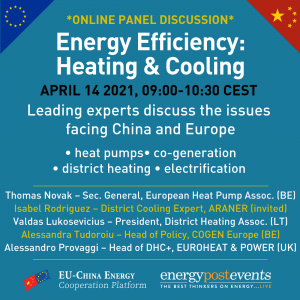CHINA: Carbon Neutral by 2060
the business opportunities for EU energy solutions providers
A series of three online workshops jointly organised by ECECP and EnergyPost.eu
WORKSHOP 3: Efficiency First – Session 3

Session Three: Heating and Cooling
09:30 to 10:30 (CET) Wednesday 14 April 2021
Transitioning from coal/fossil fuels towards an increasingly electrified world. Buildings and Industrial processes – what are the best techniques for the transition and beyond in Europe and in China? Do Europe’s best thinking and innovative solutions have a role to play on the global stage?

Thomas Nowak
Secretary General, EHPA (EUROPEAN HEAT PUMP ASSOCIATION)

Lipeng Zhang
International Consultant District Energy, representing VELUX China

Dr. Valdas Lukoševičius
President, LITHUANIAN DISTRICT HEATING ASSOCIATION

Alexandra Tudoroiu
Head of Policy, COGEN EUROPE
Highlights
Europe’s and China’s heating systems will need to decarbonise to meet both goals for net zero emissions by mid-century, and the technology to do that largely exists today.
Combined heat and power, heat pumps and district heating can all be shifted to more renewable energy sources – both power and gas – to reduce emissions and increase efficiency. Different technologies will work better for different cities or regions, depending on the availability of industries and waste plants, data centres (for waste heat), climate and government policy.
The biggest barrier is cost, giving different results for different regions. Lithuania’s renewable heating, for example, relies on biomass for 70 percent of the share. Government policies are being introduced to subsidise other technologies.
Cold temperatures are still seen as a barrier to heat pumps, especially in northern China. The industry, however, argues that the technology will work at -20 degrees Celsius for a few weeks per year, and that it can be built as a hybrid with backup fuel. Most heat pumps now use sea water or air to pump the heat, but heat from data centres are seen as the up-and-coming source of limitless energy.
There is strong scope for China and Europe to work together in expanding zero-emissions heating systems, and for Europe to provide expertise based on years of practice and legislation.
Heating in Europe
- Europe is on its way to steady decarbonisation of the heating networks.
- In Lithuania, district heating is well developed and the renewable energy share is now 70%, mainly biomass and a bit of geothermal, with some small solar.
- Lithuania’s priority is to diversify its renewable source by introducing more waste energy, hydro and geothermal.
- Gas accounts for around 40% of the energy mix, followed by 30% renewable energy.
- Through the comprehensive assessment on efficient and renewable heating and cooling, member states look at their overall demand and supply and look ahead at what sustainable solutions are cost effective for their countries.
- Europe can provide best practices. High efficiency “combined heat and power” (CHP), high efficiency district heating and heat pumps are all very well defined.
- In Lithuania, the main criteria for heat sources is the cost – and biomass is cheap and available. State policies now seek to support renewables and other sources, including raising the subsidies for non-biomass sources.
- District heating has been around a long time but is very flexible so could remain.
Heating in China
- In 2017, half of Chinese heating came from coal-fired CHP, one-third from coal boilers, most of the rest from gas and 4% from a mix of heat pumps and geothermal.
- Waste heat recovery has potential.
- Heat pumps have potential, but there are questions about whether they can cover heat demand on cold days in the north.
- The fuel mix is dominated by coal but there is a lot of opportunity to switch to gas.
- The government is paying more attention to clean heating, with eight national policies related to it in 2017. Cities that aim to develop clean heating systems can look at the national policy for specific methodology.
- China has a proposal to create a big network between nearby big cities powered by industrial waste heat and natural gas to power peak load.
- China should also be thinking about leapfrogging gas wherever possible because otherwise it may find itself with stranded assets in 20 years.
CHP: “combined heat and power”
- Asia is the biggest market for cogeneration to date. 40% of the cogeneration installed across the world is mainly in China and Japan, followed by Europe.
- In China, the economics of using gas for CHP are challenging, because electricity prices are capped low and gas prices are high.
- Europe has a very good manufacturing base for CHP and a good legislative framework that defines high-efficiency CHP.
- CHP in Europe is currently fuelled by 30% renewables (mainly biomass), but a large part still comes from coal, oil and gas, which will have to decarbonise.
Heat pumps
- They can use renewable energy, reduce CO2 emissions and are available for residential, commercial and industrial applications as well as district heating.
- Most of Europe’s biggest heat pumps operating in district heating systems are in Scandinavia, its coldest areas.
- 10% of residential heating demand is now provided by heat pump technology, mostly with renewable energy.
- The sale of heat pumps in China increased by a factor of 80 between 2015 and 2018 to nearly 4,000 units.
- The temperature is not a problem, there are solutions for -20C. The refrigerant cycle works at -20C.
- Scandinavian countries mainly use sea water at the moment.
- Data centres are up and coming and can be a limitless sources of waste heat energy.